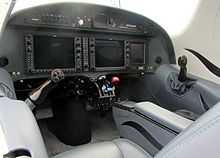Lancair Evolution
The Lancair Evolution is an American pressurized, low wing, four-place, single engine light aircraft, made from carbon fiber composite, developed by Lancair and available as an amateur-built kit.[1][2][3]
The Evolution can be powered by a Lycoming TEO-540-A piston engine or a Pratt & Whitney PT6-135A turboprop powerplant.[1][2][3][4][5]
Development
The Evolution was designed to meet the same FAR Part 23 aircraft certification standards that type certified aircraft comply with. The kit includes energy absorbing seats.[2]
The aircraft is pressurized and was designed for a 6.5 psi (0.45 bar) differential pressure, giving an 8,000 ft (2,438 m) cabin pressure at its maximum altitude of 28,000 ft (8,534 m).[6]
The turbine version of the Evolution is powered by the 750 hp (559 kW) Pratt & Whitney PT6A-135A and has a maximum cruise of 300 kn (556 km/h) at 25,000 ft (7,620 m) on a fuel burn of 39 US gal (148 l) per hour of Jet-A. Cruising at an economy cruise of 270 kn (500 km/h) at 28,000 ft (8,534 m) it burns 23 US gal (87 l) per hour. It has a full-fuel payload of 837 lb (380 kg) and a 61 kn (113 km/h) flaps-down stall speed.[5]
The piston version is powered by a Lycoming TEO-540-A2A engine and has a maximum cruising speed of 270 kn (500 km/h) on a fuel burn of 22 US gal (83 l) per hour of Avgas. At an economy cruise speed of 240 kn (444 km/h) the fuel flow is 17.5 US gal (66 l) per hour. It has a full-fuel payload of 773 lb (351 kg) and a 61 kn (113 km/h) flaps-down stall speed.[4]
The first customer kit was delivered on 22 July 2008 and production was planned at that time for two kits per month.[7] By December 2011 one piston model and 15 turbine models had been completed and flown. Construction time from the supplied kit is estimated as 1000 hours.[1]
Specifications (Evolution with PT6)

Data from Lancair and Kitplanes[1][5]
General characteristics
- Crew: one
- Capacity: three passengers
- Length: 30 ft (9.1 m)
- Wingspan: 37 ft (11 m)
- Height: 10 ft (3.0 m)
- Wing area: 132 sq ft (12.3 m2)
- Empty weight: 2,350 lb (1,066 kg)
- Gross weight: 4,350 lb (1,973 kg)
- Fuel capacity: 168 U.S. gallons (640 L; 140 imp gal)
- Powerplant: 1 × Pratt & Whitney PT6A-135A turboprop aircraft engine, 750 hp (560 kW)
Performance
- Cruising speed: 345 mph; 556 km/h (300 kn) true airspeed
- Stall speed: 70 mph; 113 km/h (61 kn) flaps down
- Never exceed speed: 295 mph; 474 km/h (256 kn)
- Range: 1,304 mi; 2,098 km (1,133 nmi) at maximum cruise speed
- Service ceiling: 28,000 ft (8,534 m) limited by RVSM
- Rate of climb: 4,000 ft/min (20 m/s)
- Wing loading: 33.0 lb/sq ft (161 kg/m2)
Related Aircraft
- Lancair Propjet
- Lancair IV-P
References
- ↑ 1.0 1.1 1.2 1.3 1.4 1.5 Vandermeullen, Richard: 2012 Kit Aircraft Buyer's Guide, Kitplanes, Volume 28, Number 12, December 2011, page 58. Belvoir Publications. ISSN 0891-1851
- ↑ 2.0 2.1 2.2 Lancair International (2012). "Performance Evolved...". Retrieved 20 October 2012.
- ↑ 3.0 3.1 Bayerl, Robby; Martin Berkemeier; et al: World Directory of Leisure Aviation 2011-12, page 106. WDLA UK, Lancaster UK, 2011. ISSN 1368-485X
- ↑ 4.0 4.1 Lancair International (2012). "Evolution Piston Specs". Retrieved 12 December 2012.
- ↑ 5.0 5.1 5.2 Lancair International (2012). "Evolution Turbine Specs". Retrieved 12 December 2012.
- ↑ Lancair International (April 2009). "LANCAIR'S EVOLUTION AIRCRAFT COMPLETES A MAJOR TESTING PHASE with FLYING COLORS". Retrieved 2009-09-28.
- ↑ Lancair International (July 2008). "First Evolution Kit Delivered". Retrieved 2009-09-28.
External links
| Wikimedia Commons has media related to Lancair. |
- Official website
- Lancair Evolution video
- Lancair Evolution First Flight video
- Lancair Evolution prototype at Airventure 2008.
| |||||
| ||||||||||||||